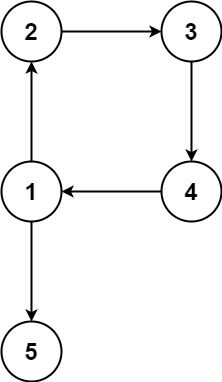In this problem, a rooted tree is a directed graph such that, there is exactly one node (the root) for which all other nodes are descendants of this node, plus every node has exactly one parent, except for the root node which has no parents.
The given input is a directed graph that started as a rooted tree with n nodes (with distinct values from 1 to n), with one additional directed edge added. The added edge has two different vertices chosen from 1 to n, and was not an edge that already existed.
The resulting graph is given as a 2D-array of edges. Each element of edges is a pair [ui, vi] that represents a directed edge connecting nodes ui and vi, where ui is a parent of child vi.
Return an edge that can be removed so that the resulting graph is a rooted tree of n nodes. If there are multiple answers, return the answer that occurs last in the given 2D-array.
Example 1:
Input: edges = [[1,2],[1,3],[2,3]] Output: [2,3]
Example 2:
Input: edges = [[1,2],[2,3],[3,4],[4,1],[1,5]] Output: [4,1]
Constraints:
n == edges.length3 <= n <= 1000edges[i].length == 21 <= ui, vi <= nui != vi
Union find.
class UnionFind:
def __init__(self, n):
self.p = list(range(n))
self.n = n
def union(self, a, b):
if self.find(a) == self.find(b):
return False
self.p[self.find(a)] = self.find(b)
self.n -= 1
return True
def find(self, x):
if self.p[x] != x:
self.p[x] = self.find(self.p[x])
return self.p[x]
class Solution:
def findRedundantDirectedConnection(self, edges: List[List[int]]) -> List[int]:
n = len(edges)
p = list(range(n + 1))
uf = UnionFind(n + 1)
conflict = cycle = None
for i, (u, v) in enumerate(edges):
if p[v] != v:
conflict = i
else:
p[v] = u
if not uf.union(u, v):
cycle = i
if conflict is None:
return edges[cycle]
v = edges[conflict][1]
if cycle is not None:
return [p[v], v]
return edges[conflict]class Solution {
public int[] findRedundantDirectedConnection(int[][] edges) {
int n = edges.length;
int[] p = new int[n + 1];
for (int i = 0; i <= n; ++i) {
p[i] = i;
}
UnionFind uf = new UnionFind(n + 1);
int conflict = -1, cycle = -1;
for (int i = 0; i < n; ++i) {
int u = edges[i][0], v = edges[i][1];
if (p[v] != v) {
conflict = i;
} else {
p[v] = u;
if (!uf.union(u, v)) {
cycle = i;
}
}
}
if (conflict == -1) {
return edges[cycle];
}
int v = edges[conflict][1];
if (cycle != -1) {
return new int[] {p[v], v};
}
return edges[conflict];
}
}
class UnionFind {
public int[] p;
public int n;
public UnionFind(int n) {
p = new int[n];
for (int i = 0; i < n; ++i) {
p[i] = i;
}
this.n = n;
}
public boolean union(int a, int b) {
int pa = find(a);
int pb = find(b);
if (pa == pb) {
return false;
}
p[pa] = pb;
--n;
return true;
}
public int find(int x) {
if (p[x] != x) {
p[x] = find(p[x]);
}
return p[x];
}
}class UnionFind {
public:
vector<int> p;
int n;
UnionFind(int _n)
: n(_n)
, p(_n) {
iota(p.begin(), p.end(), 0);
}
bool unite(int a, int b) {
int pa = find(a), pb = find(b);
if (pa == pb) return false;
p[pa] = pb;
--n;
return true;
}
int find(int x) {
if (p[x] != x) p[x] = find(p[x]);
return p[x];
}
};
class Solution {
public:
vector<int> findRedundantDirectedConnection(vector<vector<int>>& edges) {
int n = edges.size();
vector<int> p(n + 1);
for (int i = 0; i <= n; ++i) p[i] = i;
UnionFind uf(n + 1);
int conflict = -1, cycle = -1;
for (int i = 0; i < n; ++i) {
int u = edges[i][0], v = edges[i][1];
if (p[v] != v)
conflict = i;
else {
p[v] = u;
if (!uf.unite(u, v)) cycle = i;
}
}
if (conflict == -1) return edges[cycle];
int v = edges[conflict][1];
if (cycle != -1) return {p[v], v};
return edges[conflict];
}
};type unionFind struct {
p []int
n int
}
func newUnionFind(n int) *unionFind {
p := make([]int, n)
for i := range p {
p[i] = i
}
return &unionFind{p, n}
}
func (uf *unionFind) find(x int) int {
if uf.p[x] != x {
uf.p[x] = uf.find(uf.p[x])
}
return uf.p[x]
}
func (uf *unionFind) union(a, b int) bool {
if uf.find(a) == uf.find(b) {
return false
}
uf.p[uf.find(a)] = uf.find(b)
uf.n--
return true
}
func findRedundantDirectedConnection(edges [][]int) []int {
n := len(edges)
p := make([]int, n+1)
for i := range p {
p[i] = i
}
uf := newUnionFind(n + 1)
conflict, cycle := -1, -1
for i, e := range edges {
u, v := e[0], e[1]
if p[v] != v {
conflict = i
} else {
p[v] = u
if !uf.union(u, v) {
cycle = i
}
}
}
if conflict == -1 {
return edges[cycle]
}
v := edges[conflict][1]
if cycle != -1 {
return []int{p[v], v}
}
return edges[conflict]
}

